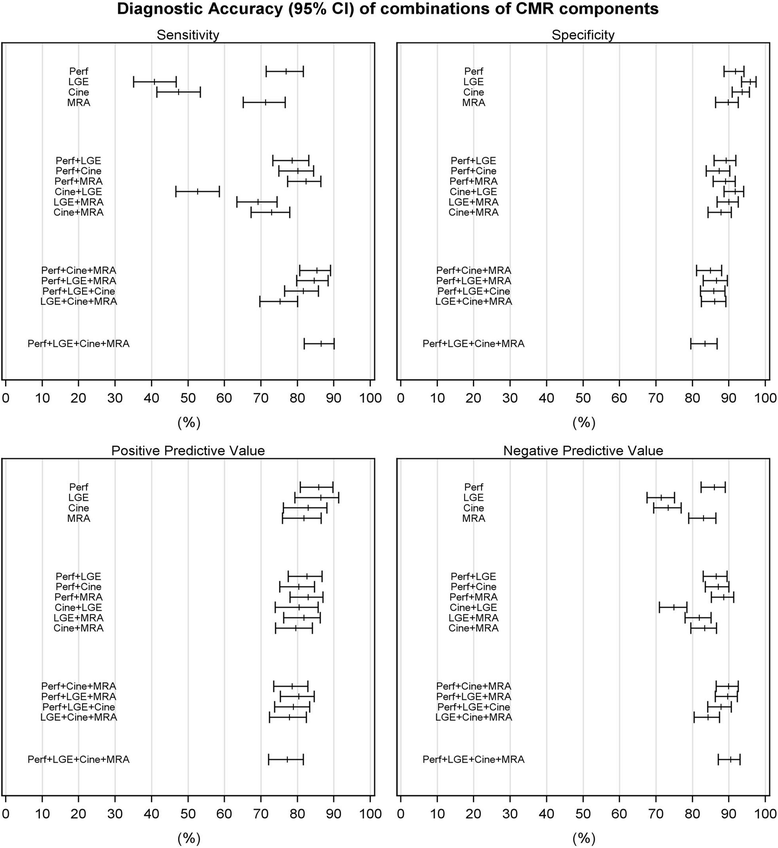Individual component analysis of the multi-parametric cardiovascular magnetic resonance protocol in the CE-MARC trial
- PMID: 26174854
- PMCID: PMC4502933
- DOI: 10.1186/s12968-015-0169-2
Individual component analysis of the multi-parametric cardiovascular magnetic resonance protocol in the CE-MARC trial
Abstract
Background: The CE-MARC study assessed the diagnostic performance investigated the use of cardiovascular magnetic resonance (CMR) in patients with suspected coronary artery disease (CAD). The study used a multi-parametric CMR protocol assessing 4 components: i) left ventricular function; ii) myocardial perfusion; iii) viability (late gadolinium enhancement (LGE)) and iv) coronary magnetic resonance angiography (MRA). In this pre-specified CE-MARC sub-study we assessed the diagnostic accuracy of the individual CMR components and their combinations.
Methods: All patients from the CE-MARC population (n = 752) were included using data from the original blinded-read. The four individual core components of the CMR protocol was determined separately and then in paired and triplet combinations. Results were then compared to the full multi-parametric protocol.
Results: CMR and X-ray angiography results were available in 676 patients. The maximum sensitivity for the detection of significant CAD by CMR was achieved when all four components were used (86.5%). Specificity of perfusion (91.8%), function (93.7%) and LGE (95.8%) on its own was significantly better than specificity of the multi-parametric protocol (83.4%) (all P < 0.0001) but with the penalty of decreased sensitivity (86.5% vs. 76.9%, 47.4% and 40.8% respectively). The full multi-parametric protocol was the optimum to rule-out significant CAD (Likelihood Ratio negative (LR-) 0.16) and the LGE component alone was the best to rue-in CAD (LR+ 9.81). Overall diagnostic accuracy was similar with the full multi-parametric protocol (85.9%) compared to paired and triplet combinations. The use of coronary MRA within the full multi-parametric protocol had no additional diagnostic benefit compared to the perfusion/function/LGE combination (overall accuracy 84.6% vs. 84.2% (P = 0.5316); LR- 0.16 vs. 0.21; LR+ 5.21 vs. 5.77).
Conclusions: From this pre-specified sub-analysis of the CE-MARC study, the full multi-parametric protocol had the highest sensitivity and was the optimal approach to rule-out significant CAD. The LGE component alone was the optimal rule-in strategy. Finally the inclusion of coronary MRA provided no additional benefit when compared to the combination of perfusion/function/LGE.
Trial registration: Current Controlled Trials ISRCTN77246133.
Figures
References
-
- Hundley WG, Bluemke DA, Finn JP, Flamm SD, Fogel MA, Friedrich MG, et al. ACCF/ACR/AHA/NASCI/SCMR 2010 expert consensus document on cardiovascular magnetic resonance: a report of the American College of Cardiology Foundation Task Force on Expert Consensus Documents. Circulation. 2010;121(22):2462–508. doi: 10.1161/CIR.0b013e3181d44a8f. - DOI - PMC - PubMed
-
- Hendel RC, Patel MR, Kramer CM, Poon M, Carr JC, Gerstad NA, et al. ACCF/ACR/SCCT/SCMR/ASNC/NASCI/SCAI/SIR 2006 appropriateness criteria for cardiac computed tomography and cardiac magnetic resonance imaging: a report of the American College of Cardiology Foundation Quality Strategic Directions Committee Appropriateness Criteria Working Group, American College of Radiology, Society of Cardiovascular Computed Tomography, Society for Cardiovascular Magnetic Resonance, American Society of Nuclear Cardiology, North American Society for Cardiac Imaging, Society for Cardiovascular Angiography and Interventions, and Society of Interventional Radiology. J Am Coll Cardiol. 2006;48(7):1475–97. doi: 10.1016/j.jacc.2006.07.003. - DOI - PubMed
-
- Montalescot G, Sechtem U, Achenbach S, Andreotti F, Arden C, Budaj A, et al. 2013 ESC guidelines on the management of stable coronary artery disease: The Task Force on the management of stable coronary artery disease of the European Society of Cardiology. Eur Heart J. 2013;34(38):2949–3003. doi: 10.1093/eurheartj/eht296. - DOI - PubMed
-
- Greenwood JP, Maredia N, Younger JF, Brown JM, Nixon J, Everett CC, et al. Cardiovascular magnetic resonance and single-photon emission computed tomography for diagnosis of coronary heart disease (CE-MARC): a prospective trial. Lancet. 2012;379(9814):453–60. doi: 10.1016/S0140-6736(11)61335-4. - DOI - PMC - PubMed
Publication types
MeSH terms
Associated data
Grants and funding
LinkOut - more resources
Full Text Sources
Other Literature Sources
Medical
Miscellaneous


